Abstract
Active packaging films based on chitosan/gelatin were prepared using a solution casting method by adding various essential oils (lime, tea tree, rosemary, and thyme essential oils), and their effects were compared. The fabricated films were characterized and various physical properties as well as the antioxidant performance of the films were studied. Adding essential oils to the polysaccharide/protein biopolymer mixtures resulted in compatible films with high transparency (>90% transparency). The mechanical strength and stiffness of the chitosan/gelatin films were improved by about 30% in the presence of essential oil, but the flexibility slightly decreased, and the stiffness improved. On the other hand, the water vapor barrier properties, thermal stability, and hydrophobicity of the essential oil-containing films were not significantly changed. Adding various essential oils significantly enhanced the antioxidant activity of chitosan/gelatin-based films. Therefore, bio-based functional films with added essential oils can be applied in active packaging applications.
Keywords:
essential oils; chitosan; gelatin; functional film; antioxidant activity; active packaging 1. Introduction
Food packaging is an integral part of the food sector to maintain food safety and quality during storage and transportation. As consumer demand for safe and fresh food increases, the use of various natural bioactive compounds as preservatives for food and of functional materials for packaging materials is increasing daily [1,2]. Among the various bioactive natural compounds available, essential oils have recently received much attention from researchers in food packaging systems due to their superior functional properties and potential to improve the shelf life of food products [3,4,5]. The strong antioxidant activity, UV-light barrier properties, and antimicrobial action of essential oils has been reported to improve the shelf life of oxidation-sensitive foods such as meat [3,6]. Numerous essential oils are available, of which tea tree, thyme, rosemary, and lime essential oils are well known and have been used in manufacturing various type of food packaging films [7,8,9]. Bioactive compounds commonly present in essential oils, such as polyphenols, flavonoids, terpenes, terpenoids, aldehydes, fatty acids, phenols, ketones, esters, alcohols, nitrogen, sulfur compounds, limonene, etc., have many functional properties [5,10]. Many reports on essential oils containing biopolymer-based packaging films have recently been published [8,11,12,13,14,15,16]. Insights into these results are promising regarding applications to active packaging materials.
Various combinations have recently been studied to manufacture biopolymer-based food packaging films [17,18,19,20]. According to recent reports, combining polysaccharides and proteins is one of the good options for making films [21,22,23,24,25,26,27,28,29]. For this purpose, chitosan, a polysaccharide, and gelatin, a protein, may be appropriate choices. Chitosan and gelatin are biopolymers that have been extensively studied to develop active and intelligent packaging films [30,31]. Recently, some literature on chitosan and gelatin blended packaging films has been published, and there are reports that chitosan and gelatin are compatible, suitable, and produce excellent films [17,32,33,34,35,36]. Adding essential oils to the chitosan/gelatin matrix is expected to improve the physical and functional properties of the films. Although many reports have already been published, comparative studies on the effects of various essential oils on biopolymer-based packaging films are limited. Comparing essential oil-added film could be useful to obtain more insights into the potential of the various essential oils in the packaging matrix. Even though essential oils are promising functional materials for active food packaging applications, the stability of the essential oils is a key factor that needs more attention for further improvement in this research field.
Therefore, this work aims to provide comparative insight into the influence of different essential oils (lime, tea tree, rosemary, and thyme) on the physical and functional properties of chitosan/gelatin films.
2. Materials and Methods
2.1. Materials
Food-grade gelatin (Type A, 200 Bloom) was procured from Gel-Tec Co. Ltd. (Seoul, Republic of Korea). Glycerol was obtained from Daejung Chemicals & Metals Co., Ltd. (Siheung, Gyeonggi-do, Republic of Korea). Lime, tea tree, rosemary, and thyme essential oil (100% natural oil) were procured from JK Group Co., Ltd. (Bucheon, Gyeonggi-do, Republic of Korea). Chitosan (viscosity: 200–800 cP at 1% acetic acid, MW: 190,000–310,000, 75–85% deacetylated), 2,2-diphenyl-1-picrylhydrazyl (DPPH), 2,2′-azino-bis(3-ethylbenzothiazoline-6-sulfonic acid) (ABTS), and potassium persulfate were acquired from Sigma-Aldrich (St. Louis, MO, USA).
2.2. Fabrication of Films
Various essential oil (lime, tea tree, rosemary, and thyme)-added chitosan/gelatin-based functional film was prepared using a solution casting method [17]. For the preparation of the film solution, 2 g of chitosan was first dissolved in 100 mL of 1% acetic acid solution at room temperature with continuous stirring overnight. Next, 2 g of gelatin was dissolved in 100 mL of distilled water at 80 °C with slight agitation. After mixing the completely dissolved biopolymer solution, glycerol (30 wt% based on polymer) was added as a plasticizer and stirred at room temperature for 1 h. Then, 2 wt% (based on polymer) of each essential oil was individually dispersed in an aqueous solution, and added to the biopolymer mixture with vigorous stirring using Tween 80 as an emulsifier. The film solution was then cast on a flat Teflon film-coated glass plate, dried at room temperature for 48 h, and stored in a humidity chamber controlled at 25 °C and 50% RH. In addition, a control chitosan/gelatin film without essential oil was prepared following the same procedure. The fabricated films were named ChsG, ChsG/Lim, ChsG/TT, ChsG/RO, and ChsG/Thy according to the essential oil used. The schematic representation of the fabrication of essential oil-added film is shown in Scheme 1.
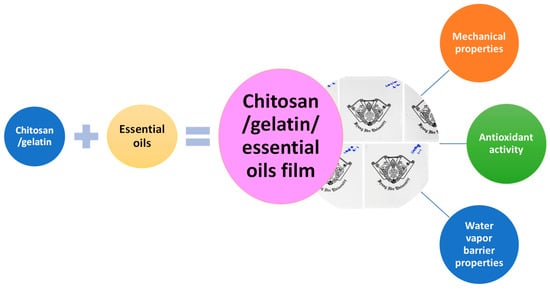
Scheme 1.
The preparation procedure diagram of essential oil-added chitosan/gelatin-based active packaging film.
2.3. Experimental
2.3.1. Characterization and Properties of the Film
Surface Color and Light Transmittance
The surface color of the films was measured using a Chroma meter (Konica Minolta, CR-400, Tokyo, Japan) with a white color plate (L = 97.75, a = −0.49, and b = 1.96) as a standard background for color measurement. The total color difference (∆E) was determined using the following equation:
where ∆L, ∆a, and ∆b are the difference between each color value of the standard color plate and film sample.
The UV-vis transmission spectra of the films were recorded using a spectrophotometer (Mecasys Optizen POP Series UV-vis spectrophotometer, Seoul, Republic of Korea) in the wavelength range of 200–800 nm. The UV-barrier and transparency properties of the film were assessed by determining the percent light transmittance of the film at 280 nm (T280) and 660 nm (T660), correspondingly [23].
Surface Morphology and FTIR
The film’s surface morphology was detected using field emission scanning electron microscopy (FE-SEM, SU 8010, Hitachi Co., Ltd., Matsuda, Japan) at an accelerating voltage of 2 kV. Before measurement, all the film specimens were sputter coated with platinum for 120 s. FTIR spectra of the film samples were noted at a wavenumber of 4000–500 cm−1 with the resolution of 32 scans at 4 cm−1 using a TENSOR 37 Spectrophotometer with OPUS 6.0 software (Billerica, MA, USA).
The Mechanical Properties
The film sample’s thickness was measured using a hand-held digital micrometer (Digimatic Micrometer, QuantuMike IP 65, Mitutoyo, Japan) with an accuracy of 1 μm. The film thickness was measured at five random locations of each film sample, and their average was used. The film’s mechanical properties, such as tensile strength (TS), elongation at break (EB), and elastic modulus (EM), were determined following the standard method of ASTM D 882-88 using an Instron Universal Testing Machine (Model 5565, Instron Engineering Corporation, Canton, MA, USA). The Instron machine was operated with an initial grip separation of 50 mm and a crosshead speed of 50 mm/min [26].
Water Vapor Permeability (WVP) and Water Contact Angle (WCA)
The WVP of the composite films was determined gravimetrically using a WVP cup following the ASTM E96-95 standard method. At first, the WVP cup was filled with a prescribed amount of water, then covered by the films, sealed, and kept in the controlled environmental chamber at 25 °C and 50% RH. After equilibration, the WVP cup’s weight was measured at every one-hour interval, and weight loss was calculated. The WVTR (g/m2.s) was determined from the slope (linear) of the steady-state portion of weight loss of the cup versus the time curve. Then, the WVP of the films was calculated in g.m/m2.Pa.s as follows [29]:
L was the film’s thickness (m), and Δp was the partial water vapor pressure difference (Pa) across the film.
WVP = (WVTR × L)/Δp
The film’s surface wettability was determined by computing the water contact angle of the film surface using a WCA analyzer (Phoneix 150, Surface Electro Optics Co., Ltd., Kunpo, Republic of Korea). The film sample was cut (3 cm × 10 cm) and then fixed on the holder. A drop of water (~10 μL) was added to the film’s surface using a micro syringe and the WCA was read.
Thermal Stability
The films’ thermal stability was determined using a thermogravimetric analyzer (Hi-Res TGA 2950, TA Instrument, New Castle, DE, USA). For the measurement, ~10 mg of film sample was taken in a standard aluminum pan and scanned at a heating rate of 10 °C/min in a temperature range of 30–600 °C under a nitrogen flow of 50 cm3/min with an empty pan as a reference.
Antioxidant Activity
Antioxidant activities of the films were measured by assessing the free radical scavenging activity [29]. Both DPPH and ABTS assay were used to check the antioxidant potential of the chiotosan/gelatin-based packaging film. For DPPH analysis, a prescribed amount of methanolic solution of DPPH was freshly made, and ~50 mg of tested film sample was added in a 10 mL DPPH solution and incubated at room temperature for 30 min, then the absorbance was measured at 517 nm. For the ABTS assay, a prescribed amount of potassium sulfate was added to the ABTS solution, followed by overnight incubation in the dark to make the ABTS assay solution. Then, ~50 mg of tested film samples was added to 10 mL of ABTS assay solution, incubated at room temperature for 30 min, and the absorbance was measured at 734 nm. The antioxidative activity of all the tested films was calculated as follows:
where Ac and At were the absorbance of DPPH/ABTS of the control and test film. All the tests were performed in triplicate, and the average value was reported.
Statistical Analysis
The film properties were measured in triplicate with individually prepared films. One-way analysis of variance (ANOVA) was performed to compare the differences among the samples, and the significance of each mean property value was determined (p < 0.05) by Duncan’s multiple range test using the SPSS statistical analysis computer program for Windows (SPSS Inc., Chicago, IL, USA).
3. Results and Discussion
3.1. Microstructure
The surface morphology of the essential oil-doped films was confirmed using field emission scanning electron microscopy, and the results are shown in Figure 1. The control film was observed to be smooth and free of voids or cracks, which was consistent with chitosan and gelatin. Previous reports on chitosan/gelatin-based films also support good compatibility [36]. Adding essential oils to a biopolymer mixture results in only minor changes to its full form. Most importantly, the essential oils were well dispersed in the polymer mixture, and the film surface’s roughness seemed to increase. Overall, including various essential oils suggests a film compatible with chitosan/gelatin has been developed. Similar results have recently been reported for essential oils with various biopolymer-based films [12,37,38].
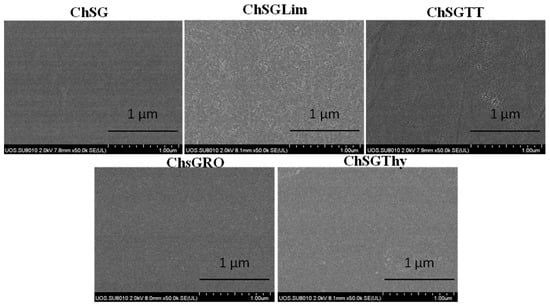
Figure 1.
SEM images of various essential oil-added chitosan/gelatin-based films.
3.2. FTIR
The FTIR spectra were used to evaluate the chemical interaction between the biopolymers and the essential oils, and the results are shown in Figure 2. The peak observed at 3294 cm−1 was due to the O-H stretching and N-H vibration of the chitosan and gelatin [39]. The peak at 2932 cm−1 appeared owing to the C-H stretching vibrations of alkane groups of the chitosan [40]. The peak at 1641 and 1544 cm−1 was attributed to the carbonyl group (amide I) and N-H stretching vibration, respectively [41]. The peaks observed at 1452, 1399, and 1230 cm−1 were attributed to C-N and N-H stretching, O-H bending, and amide-III of the gelatin, respectively [42]. The peak at 1158 cm−1 was due to the stretching vibration of the saccharide structure, while that at 1025 cm−1 denoted the C=O stretching bond vibration of chitosan [43]. The peaks for chitosan and gelatin were spotted in the control and all other essential oil-added films, indicating good miscibility and compatibility among the two biopolymers. The FTIR spectra were similar to the previously reported chitosan/gelatin-based films [44]. Mixing various essential oils only showed variation in peak intensity or slight shifting in peak position. Apart from that, no new peak was observed that suggested the interaction among the fillers and polymers is based on physical forces such as van der Walls forces, electrostatic interaction, and hydrogen bonds [45,46]. Similar results have recently been reported for biopolymer-based packaging films with essential oils [17,47]. The effect of essential oils on the chemical interaction with biopolymers can be varied depending on many factors such as polymer type, essential oils type, and fabrication method. In some cases, the addition of essential oils in biopolymer films showed some alteration in chemical characteristics which could be due to adding an emulsifier or added materials to produce a Pickering emulsion. The FTIR results showed that the addition of essential oils to biopolymers did not significantly affect their chemical properties.
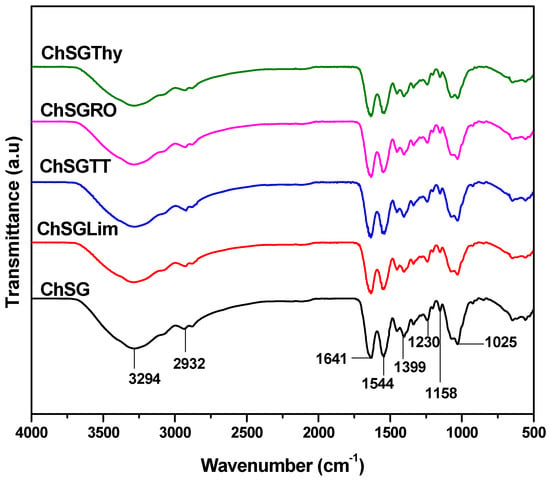
Figure 2.
FTIR spectra of various essential oil-added chitosan/gelatin films.
3.3. Thermal Stability
The thermal stability of all chitosan/gelatin-based films was verified using thermogravimetry, and the results are presented in Figure 3. In the thermogravimetric analysis (TGA) and derivative thermogravimetric (DTG) thermograms, it can be detected that all films show two major decomposition peaks. The degradation pattern of the film was similar to previously reported chitosan/gelatin-based films. The first degradation maxima found at around 60–100 °C were due to the evaporation of moisture in the film [17]. A second and main thermal decomposition peak occurred around 300 °C due to biopolymers and glycerol degradation [36]. Slight changes in peak patterns and maximum peaks were observed in the presence of different essential oils. In addition, except for the increase in residual char content in the case of the film with rosemary essential oil added, the residual char content of the other films remained similar to that of the control film. The higher char content (~40%) may be due to non-combustible materials such as minerals and impurities present in the polymers [48]. It can be inferred that the thermal stability of the chitosan/gelatin-based films did not change significantly in the presence of essential oils. Similar results have been reported for essential oils in other biopolymer-based packaging films [36,49].
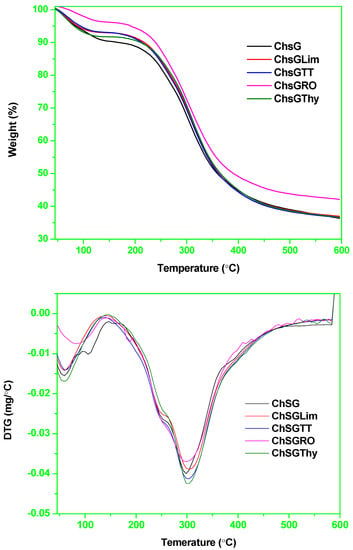
Figure 3.
TGA and DTG thermogram of various essential oil-added chitosan/gelatin films.
3.4. Optical Properties of the Film
The surface color of chitosan/gelatin-based films was studied, and the results are presented in Table 1. The brightness of the control film was ~90%, and although adding essential oil slightly increased the brightness, the change was not statistically significant. On the other hand, the a and b values of the film increased only slightly, and the changes were again not very expressive. Since adding essential oils did not result in significant surface color changes, the film’s overall color difference also did not change. The essential oils used were all close to colorless and did not significantly affect the color of the chitosan/gelatin-based films (Figure 4). Similar results have been reported for biopolymer-based packaging films with added essential oils [36,49].

Table 1.
Surface color and light transmittance of the chitosan/gelatin-based functional films.
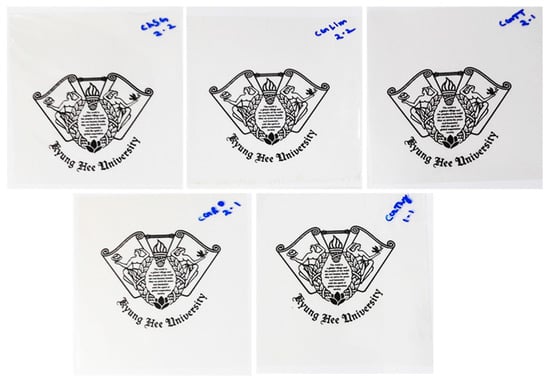
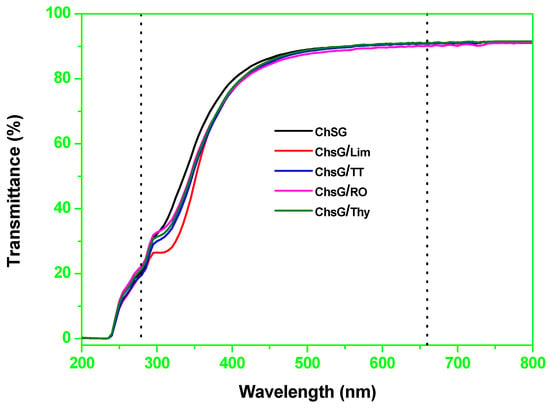
Figure 4.
Apparent image and UV-vis light transmission spectra of essential oil-added chitosan/gelatin-based films.
For more insight into the optical properties of essential oils with chitosan/gelatin-based films, we checked the UV-vis transmission spectrum, and the results are shown in Figure 4. The neat films showed high light transmittance and incorporation of essential oils. The transmittance was not sharply reduced. The film’s UV-barrier (Transmittance at 280 nm, T280) and transparency (Transmittance at 660 nm, T660) properties were determined, and the results are shown in Table 1. The control film showed some UV-barrier properties that may be due to UV light absorption by the aromatic amino acid moieties in the gelatin [50]. The sunscreen properties of essential oils with films are somewhat improved due to bioactive compounds such as polyphenols in essential oils [22]. The light protection properties were highest for tea tree oil, followed by lime, thyme, and rosemary oils. The optical transmittance is similar to previously reported chitosan/gelatin-based packaging films. On the other hand, the transparency of the film was very high (>90%), very similar to previously reported data [39,51]. The high transparency of the film was maintained by adding essential oils. Similar results have been reported in the case of biopolymer-based packaging films with essential oils [51,52].
3.5. Mechanical and Water Vapor Barrier Properties
The thickness and mechanical properties of the chitosan/gelatin-based film were studied, and the results are shown in Table 2. The thicknesses of the control and essential oil-added films were almost similar. In mechanical properties, three parameters were studied: mechanical strength, flexibility, and stiffness. The mechanical strength of the control chitosan/gelatin film was ~80 MPa, which is considered high for a biopolymer-based film. The results are consistent with previously reported data [17]. The mechanical strength increased significantly in all the essential oil-added films. An increase in the mechanical strength of chitosan/gelatin films of about 30% was observed. The film’s highest mechanical strength was observed with thyme oil added, followed by rosemary, lime, and tea tree [53,54]. At the same time, the elongation at break (EB) and the stiffness of the films with added essential oil decreased and increased, respectively. Insights from testing mechanical properties implying the inclusion of essential oils in chitosan/gelatin films formed a mechanically strong but less flexible type of film. Similar results were also reported for packaging films based on biopolymers containing films containing essential oils [17,39].

Table 2.
Mechanical properties, water vapor permeability (WVP), and water contact angle (WCA) of the chitosan/gelatin-based composite films.
The water vapor transmission rate of any biopolymer-made composite film is an imperative parameter and is primarily reliant on the kind of matrix polymer used for the fabrication of the film as well as on the filler and matrix interactions. The water vapor barrier properties are reciprocally related to the water vapor permeability of the film. The water vapor permeability of chitosan/gelatin films is also shown in Table 2. The water vapor permeability of the films was observed to decrease or increase only slightly in the presence of essential oils, but the changes were insignificant. The vapor barrier properties lead to insights indicating that the vapor barrier properties of chitosan/gelatin-based films are slightly changed or unchanged in the presence of essential oils. The WVP was largely reliant on three parameters—water vapor absorption on the film surface, dissemination of water from the film, and water evaporation from the external surface of the film. Similar results were recently reported for essential oil-blended gelatin/chitosan-based packaging films [17,39].
3.6. Hydrophobicity
The WCA was calculated to check the hydrophilicity of the packaging film. The water contact angle of essential oils containing chitosan/gelatin films was studied to confirm the hydrophobicity of the films, and the results are presented in Table 2. The control film has a WCA of ~52°, indicating a hydrophilic surface. The addition of lime essential oil slightly decreased the WCA, while the addition of rosemary, thyme, and tea tree essential oils slightly increased the WCA of the film, but the difference was not statistically significant (p > 0.05). Since the film is hydrophilic and the essential oil is hydrophobic, it was expected that mixing them would increase the WCA of the film. The WCA of the composite film did not increase significantly because the essential oil’s hydrophobic effect was attenuated by adding an emulsifier (Tween 80) [55]. Similar results have been reported for biopolymer-based packaging films incorporated with essential oils [17,49,56].
3.7. Antioxidant Activity
The antioxidant activity of chitosan/gelatin films was studied using DPPH and ABTS tests, and the results are shown in Figure 5. The control chitosan/gelatin film showed significant antioxidant activity, probably due to the presence of bioactive functional groups such as hydroxyl and amino groups. Antioxidant activity of the films was higher in the ABTS assay than in DPPH because the dissolution of the polymer is faster in an aqueous solution of the ABTS analysis than in an alcoholic solution of DPPH analysis, facilitating the release of active ingredients [57]. The antioxidant activity of the chitosan/gelatin films was tremendously enhanced in the presence of all essential oils, as expected due to the antioxidant potential of the added essential oils. Lime, thyme, tea tree, and rosemary essential oils contain many bioactive components, such as phenols, flavonoids, and terpenoids, which are well-known free radical scavengers [9,58]. The highest antioxidant activity was observed for thyme oil (100% increase), rosemary (60% increase), tea tree (55% increase), and lime (25% increase) essential oils for this variant versus the control chitosan/gelatin film. The different antioxidant activity of the composite films may be due to the different compositions of essential oils and the varying release of bioactive components from polymer matrices. It has often been observed that the bioactive ingredient functionlized packaging films’ antioxidant activity varied greatly when different polymers were used. Similar antioxidant activity results were previously reported for packaging films infused with essential oils [12,59].
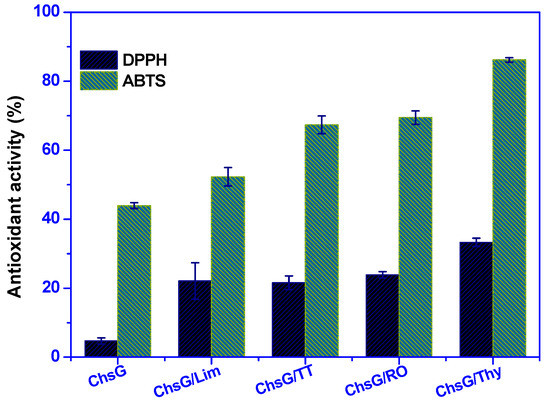
Figure 5.
Antioxidant activity of various essential oil-added chitosan/gelatin films.
Biopolymer-based packaging is a promising alternative to synthetic plastics, however, focusing on mass production and making it available to the masses at lower production costs is essential. The cost of biopolymer-based films is an important parameter, and it is known that the cost of biopolymer-based films is around USD 3–3.5/kg [1]. Meanwhile, according to a report from China’s Jining Mingsheng New Material Co., Ltd., the estimated cost of making a bioplastic-based film is USD 3.6 per kg [60,61]. Although the packaging cost will increase slightly due to the addition of essential oils, the cost of adding essential oils can be offset by the advantages of securing safety, maintaining quality, and extending the shelf life of packaged foods.
4. Conclusions
Active packaging films were prepared by adding essential oils to a chitosan/gelatin polymer matrix. The essential oils (lime, tea tree, rosemary, and thyme essential oils) are compatible with biopolymers, as shown in electron microscopy images. The neat chitosan/gelatin film was transparent (more than 90% transparency) and maintained the same level of transparency even when essential oil was added. Blending essential oils significantly improved the mechanical strength (~30%) of the chitosan/gelatin-based composite film. The film’s stiffness also improved similarly to the mechanical strength, but the flexibility decreased. The antioxidant activity of the chitosan/gelatin films was highest for thyme oil (100% increase) and lowest for lime oil (25% increase) compared to the control film. The films’ thermal, water vapor barrier properties, and hydrophobicity did not change significantly in the presence of essential oils. The chitosan/gelatin-based functional films with added essential oils have a high potential for active food packaging applications. Even though packaging film with included essential oils has many advantages, they also suffer certain restrictions. The key constraint of applications of essential oils as bioactive functional compounds in packaging material is their high volatility, low solubility, and their strong flavor. Further research work is needed to improve the stability of essential oils and their solubility in packaging matrix.
Author Contributions
Conceptualization, S.R.; methodology, S.R.; software, S.R.; validation, S.R. and J.-W.R.; formal analysis, S.R. and S.-J.M.; investigation, S.R. and S.-J.M.; resources, J.-W.R.; data curation, S.R. and S.-J.M.; writing-original draft preparation, S.R.; writing-review and editing, S.R. and J.-W.R.; visualization, S.R. and J.-W.R.; supervision, J.-W.R.; project administration, J.-W.R.; funding acquisition, J.-W.R. All authors have read and agreed to the published version of the manuscript.
Funding
This work was supported by the National Research Foundation of Korea (NRF) grant funded by the Korean government (MSIT) (No. 2022R1A2B02001422).
Data Availability Statement
Not applicable.
Conflicts of Interest
The authors declare no conflict of interest.
References
- Gupta, V.; Biswas, D.; Roy, S. A Comprehensive Review of Biodegradable Polymer-Based Films and Coatings and Their Food Packaging Applications. Materials 2022, 15, 5899. [Google Scholar] [CrossRef]
- Roy, S.; Zhang, W.; Biswas, D.; Ramakrishnan, R.; Rhim, J.-W. Grapefruit Seed Extract-Added Functional Films and Coating for Active Packaging Applications: A Review. Molecules 2023, 28, 730. [Google Scholar] [CrossRef]
- Smaoui, S.; Ben Hlima, H.; Tavares, L.; Ennouri, K.; Ben Braiek, O.; Mellouli, L.; Abdelkafi, S.; Mousavi Khaneghah, A. Application of Essential Oils in Meat Packaging: A Systemic Review of Recent Literature. Food Control. 2022, 132, 108566. [Google Scholar] [CrossRef]
- Atarés, L.; Chiralt, A. Essential Oils as Additives in Biodegradable Films and Coatings for Active Food Packaging. Trends Food Sci. Technol. 2016, 48, 51–62. [Google Scholar] [CrossRef]
- Anis, A.; Pal, K.; Al-Zahrani, S.M. Essential Oil-Containing Polysaccharide-Based Edible Films, and Coatings for Food Security Applications. Polymers 2021, 13, 575. [Google Scholar] [CrossRef] [PubMed]
- Chacha, J.S.; Ofoedu, C.E.; Xiao, K.; James Chacha, C.S. Essential Oil-Based Active Polymer-Based Packaging System: A Review of Its Effect on the Antimicrobial, Antioxidant, and Sensory Properties of Beef and Chicken Meat. J. Food Process. Preserv. 2022, 46, e16933. [Google Scholar] [CrossRef]
- Sánchez Aldana, D.; Andrade-Ochoa, S.; Aguilar, C.N.; Contreras-Esquivel, J.C.; Nevárez-Moorillón, G.V. Antibacterial Activity of Pectic-Based Edible Films Incorporated with Mexican Lime Essential Oil. Food Control. 2015, 50, 907–912. [Google Scholar] [CrossRef]
- Roy, S.; Rhim, J.-W. Carrageenan/Agar-Based Functional Film Integrated with Zinc Sulfide Nanoparticles and Pickering Emulsion of Tea Tree Essential Oil for Active Packaging Applications. Int. J. Biol. Macromol. 2021, 193, 2038–2046. [Google Scholar] [CrossRef] [PubMed]
- Sarıcaoglu, F.T.; Turhan, S. Physicochemical, Antioxidant and Antimicrobial Properties of Mechanically Deboned Chicken Meat Protein Films Enriched with Various Essential Oils. Food Packag. Shelf Life 2020, 25, 100527. [Google Scholar] [CrossRef]
- Zhang, W.; Roy, S.; Rhim, J.-W. Copper-based nanoparticles for biopolymer-based functional films in food packaging applications. Compr. Rev. Food Sci. Food Saf. 2023, in press. [CrossRef]
- Roy, S.; Rhim, J.-W. Gelatin/Agar-Based Functional Film Integrated with Pickering Emulsion of Clove Essential Oil Stabilized with Nanocellulose for Active Packaging Applications. Colloids Surfaces A Physicochem. Eng. Asp. 2021, 627, 127220. [Google Scholar] [CrossRef]
- Roy, S.; Priyadarshi, R.; Rhim, J.-W. Gelatin/Agar-Based Multifunctional Film Integrated with Copper-Doped Zinc Oxide Nanoparticles and Clove Essential Oil Pickering Emulsion for Enhancing the Shelf Life of Pork Meat. Food Res. Int. 2022, 160, 111690. [Google Scholar] [CrossRef]
- Martins, P.C.; Bagatini, D.C.; Martins, V.G. Oregano Essential Oil Addition in Rice Starch Films and Its Effects on the Chilled Fish Storage. J. Food Sci. Technol. 2021, 58, 1562–1573. [Google Scholar] [CrossRef]
- Xiong, Y.; Li, S.; Warner, R.D.; Fang, Z. Effect of Oregano Essential Oil and Resveratrol Nanoemulsion Loaded Pectin Edible Coating on the Preservation of Pork Loin in Modified Atmosphere Packaging. Food Control. 2020, 114, 107226. [Google Scholar] [CrossRef]
- Seydim, A.C.; Sarikus-Tutal, G.; Sogut, E. Effect of Whey Protein Edible Films Containing Plant Essential Oils on Microbial Inactivation of Sliced Kasar Cheese. Food Packag. Shelf Life 2020, 26, 100567. [Google Scholar] [CrossRef]
- Zehra, A.; Mohd Wani, S.; Jan, N.; Bhat, T.A.; Rather, S.A.; Malik, A.R.; Hussain, S.Z. Development of Chitosan-Based Biodegradable Films Enriched with Thyme Essential Oil and Additives for Potential Applications in Packaging of Fresh Collard Greens. Sci. Rep. 2022, 12, 16923. [Google Scholar] [CrossRef] [PubMed]
- Roy, S.; Rhim, J.-W. Genipin-Crosslinked Gelatin/Chitosan-Based Functional Films Incorporated with Rosemary Essential Oil and Quercetin. Materials 2022, 15, 3769. [Google Scholar] [CrossRef]
- Zong, Z.; Liu, M.; Chen, H.; Farag, M.A.; Wu, W.; Fang, X.; Niu, B.; Gao, H. Preparation and Characterization of a Novel Intelligent Starch/Gelatin Binary Film Containing Purple Sweet Potato Anthocyanins for Flammulina Velutipes Mushroom Freshness Monitoring. Food Chem. 2023, 405, 134839. [Google Scholar] [CrossRef] [PubMed]
- Rukmanikrishnan, B.; Ramalingam, S.; Rajasekharan, S.K.; Lee, J.; Lee, J. Binary and Ternary Sustainable Composites of Gellan Gum, Hydroxyethyl Cellulose and Lignin for Food Packaging Applications: Biocompatibility, Antioxidant Activity, UV and Water Barrier Properties. Int. J. Biol. Macromol. 2020, 153, 55–62. [Google Scholar] [CrossRef]
- Roy, S.; Rhim, J.-W. Gelatin/Cellulose Nanofiber-Based Functional Films Added with Mushroom-Mediated Sulfur Nanoparticles for Active Packaging Applications. J. Nanostruct. Chem. 2022, 12, 979–990. [Google Scholar] [CrossRef]
- Roy, S.; Biswas, D.; Rhim, J.W. Gelatin/cellulose nanofiber-based functional nanocomposite film incorporated with zinc oxide nanoparticles. J. Compos. Sci. 2022, 6, 223. [Google Scholar] [CrossRef]
- Haghighi, H.; Biard, S.; Bigi, F.; De Leo, R.; Bedin, E.; Pfeifer, F.; Siesler, H.W.; Licciardello, F.; Pulvirenti, A. Comprehensive Characterization of Active Chitosan-Gelatin Blend Films Enriched with Different Essential Oils. Food Hydrocoll. 2019, 95, 33–42. [Google Scholar] [CrossRef]
- Roy, S.; Rhim, J.-W. Preparation of Gelatin/Carrageenan-Based Color-Indicator Film Integrated with Shikonin and Propolis for Smart Food Packaging Applications. ACS Appl. Bio Mater. 2021, 2021, 770–779. [Google Scholar] [CrossRef]
- Jamróz, E.; Juszczak, L.; Kucharek, M. Development of Starch-Furcellaran-Gelatin Films Containing Tea Tree Essential Oil. J. Appl. Polym. Sci. 2018, 135, 46754. [Google Scholar] [CrossRef]
- Tongdeesoontorn, W.; Mauer, L.J.; Wongruong, S.; Sriburi, P.; Reungsang, A.; Rachtanapun, P. Antioxidant Films from Cassava Starch/Gelatin Biocomposite Fortified with Quercetin and TBHQ and Their Applications in Food Models. Polymers 2021, 13, 1117. [Google Scholar] [CrossRef]
- Roy, S.; Ezati, P.; Biswas, D.; Rhim, J.-W. Shikonin Functionalized Packaging Film for Monitoring the Freshness of Shrimp. Materials 2022, 15, 6615. [Google Scholar] [CrossRef]
- Ezati, P.; Roy, S.; Rhim, J.-W. Pectin/Gelatin-Based Bioactive Composite Films Reinforced with Sulfur Functionalized Carbon Dots. Colloids Surfaces A Physicochem. Eng. Asp. 2021, 636, 128123. [Google Scholar] [CrossRef]
- Zhang, C.; Gao, D.; Ma, Y.; Zhao, X. Effect of Gelatin Addition on Properties of Pullulan Films. J. Food Sci. 2013, 78, C805–C810. [Google Scholar] [CrossRef] [PubMed]
- Roy, S.; Ezati, P.; Rhim, J.-W. Fabrication of Antioxidant and Antimicrobial Pullulan/Gelatin Films Integrated with Grape Seed Extract and Sulfur Nanoparticles. ACS Appl. Bio Mater. 2022, 5, 2316–2323. [Google Scholar] [CrossRef]
- Yu, D.; Yu, Z.; Zhao, W.; Regenstein, J.M.; Xia, W. Advances in the Application of Chitosan as a Sustainable Bioactive Material in Food Preservation. Crit. Rev. Food Sci. Nutr. 2020, 62, 3782–3797. [Google Scholar] [CrossRef]
- Ahmad, M.S.; Ali, R.R.; Majid, R.A.; Mohamad, Z. Properties Enhancement of Packaging Materials Based on Gelatin; Wiley: Hoboken, NJ, USA, 2022. [Google Scholar] [CrossRef]
- Fu, B.; Liu, Q.; Liu, M.; Chen, X.; Lin, H.; Zheng, Z.; Zhu, J.; Dai, C.; Dong, X.; Yang, D.-P. Carbon Dots Enhanced Gelatin/Chitosan Bio-Nanocomposite Packaging Film for Perishable Foods. Chin. Chem. Lett. 2022, 33, 4577–4582. [Google Scholar] [CrossRef]
- Kakaei, S.; Shahbazi, Y. Effect of Chitosan-Gelatin Film Incorporated with Ethanolic Red Grape Seed Extract and Ziziphora Clinopodioides Essential Oil on Survival of Listeria Monocytogenes and Chemical, Microbial and Sensory Properties of Minced Trout Fillet. LWT Food Sci. Technol. 2016, 72, 432–438. [Google Scholar] [CrossRef]
- Yan, J.; Zhang, H.; Yuan, M.; Qin, Y.; Chen, H. Effects of Anthocyanin-Rich Kadsura coccinea Extract on the Physical, Antioxidant, and PH-Sensitive Properties of Biodegradable Film. Food Biophys. 2022, 17, 375–385. [Google Scholar] [CrossRef]
- Xu, M.; Yu, H.; Chen, X.; Yuan, G. Physico-Chemical, Biological Properties of Chitosan/Gelatin-Based Films with Finger Millet Bran Extract. J. Food Meas. Charact. 2022, 16, 2939–2947. [Google Scholar] [CrossRef]
- Roy, S.; Rhim, J.-W. Fabrication of Bioactive Binary Composite Film Based on Gelatin/Chitosan Incorporated with Cinnamon Essential Oil and Rutin. Colloids Surf. B Biointerfaces 2021, 204, 111830. [Google Scholar] [CrossRef] [PubMed]
- Fasihi, H.; Noshirvani, N.; Hashemi, M. Novel Bioactive Films Integrated with Pickering Emulsion of Ginger Essential Oil for Food Packaging Application. Food Biosci. 2023, 51, 102269. [Google Scholar] [CrossRef]
- Lian, H.; Shi, J.; Zhang, X.; Peng, Y. Effect of the Added Polysaccharide on the Release of Thyme Essential Oil and Structure Properties of Chitosan Based Film. Food Packag. Shelf Life 2020, 23, 100467. [Google Scholar] [CrossRef]
- Kumar, S.; Shukla, A.; Baul, P.P.; Mitra, A.; Halder, D. Biodegradable Hybrid Nanocomposites of Chitosan/Gelatin and Silver Nanoparticles for Active Food Packaging Applications. Food Packag. Shelf Life 2018, 16, 178–184. [Google Scholar] [CrossRef]
- Wang, S.; Xia, P.; Wang, S.; Liang, J.; Sun, Y.; Yue, P.; Gao, X. Packaging Films Formulated with Gelatin and Anthocyanins Nanocomplexes: Physical Properties, Antioxidant Activity and Its Application for Olive Oil Protection. Food Hydrocoll. 2019, 96, 617–624. [Google Scholar] [CrossRef]
- Kim, H.-J.; Roy, S.; Rhim, J.-W. Gelatin/Agar-Based Color-Indicator Film Integrated with Clitoria Ternatea Flower Anthocyanin and Zinc Oxide Nanoparticles for Monitoring Freshness of Shrimp. Food Hydrocoll. 2022, 124, 107294. [Google Scholar] [CrossRef]
- Khoshkalampour, A.; Ghorbani, M.; Ghasempour, Z. Cross-Linked Gelatin Film Enriched with Green Carbon Quantum Dots for Bioactive Food Packaging. Food Chem. 2023, 404, 134742. [Google Scholar] [CrossRef]
- Lee, S.J.; Gwak, M.A.; Chathuranga, K.; Lee, J.S.; Koo, J.; Park, W.H. Multifunctional Chitosan/Tannic Acid Composite Films with Improved Anti-UV, Antioxidant, and Antimicrobial Properties for Active Food Packaging. Food Hydrocoll. 2023, 136, 108249. [Google Scholar] [CrossRef]
- Hari, N.; Francis, S.; Rajendran Nair, A.G.; Nair, A.J. Synthesis, Characterization and Biological Evaluation of Chitosan Film Incorporated with β-Carotene Loaded Starch Nanocrystals. Food Packag. Shelf Life 2018, 16, 69–76. [Google Scholar] [CrossRef]
- Grzebieniarz, W.; Biswas, D.; Roy, S.; Jamróz, E. Advances in Biopolymer-Based Multi-Layer Film Preparations and Food Packaging Applications. Food Packag. Shelf Life 2023, 35, 101033. [Google Scholar] [CrossRef]
- Mansur, H.S.; Sadahira, C.M.; Souza, A.N.; Mansur, A.A.P. FTIR Spectroscopy Characterization of Poly(Vinyl Alcohol) Hydrogel with Different Hydrolysis Degree and Chemically Crosslinked with Glutaraldehyde. Mater. Sci. Eng. C 2008, 28, 539–548. [Google Scholar] [CrossRef]
- Guo, Y.; Chen, X.; Yang, F.; Wang, T.; Ni, M.; Chen, Y.; Yang, F.; Huang, D.; Fu, C.; Wang, S. Preparation and Characterization of Chitosan-Based Ternary Blend Edible Films with Efficient Antimicrobial Activities for Food Packaging Applications. J. Food Sci. 2019, 84, 1411–1419. [Google Scholar] [CrossRef] [PubMed]
- Kumar, S.; Mudai, A.; Roy, B.; Basumatary, I.B.; Mukherjee, A.; Dutta, J. Biodegradable Hybrid Nanocomposite of Chitosan/Gelatin and Green Synthesized Zinc Oxide Nanoparticles for Food Packaging. Foods 2020, 9, 1143. [Google Scholar] [CrossRef] [PubMed]
- Hosseini, S.F.; Rezaei, M.; Zandi, M.; Farahmandghavi, F. Development of Bioactive Fish Gelatin/Chitosan Nanoparticles Composite Films with Antimicrobial Properties. Food Chem. 2016, 194, 1266–1274. [Google Scholar] [CrossRef]
- Yadav, S.; Mehrotra, G.K.; Bhartiya, P.; Singh, A.; Dutta, P.K. Preparation, Physicochemical and Biological Evaluation of Quercetin Based Chitosan-Gelatin Film for Food Packaging. Carbohydr. Polym. 2020, 227, 115348. [Google Scholar] [CrossRef]
- Cai, L.; Shi, H.; Cao, A.; Jia, J. Characterization of Gelatin/Chitosan Ploymer Films Integrated with Docosahexaenoic Acids Fabricated by Different Methods. Sci. Rep. 2019, 9, 8375. [Google Scholar] [CrossRef]
- Pereda, M.; Ponce, A.G.; Marcovich, N.E.; Ruseckaite, R.A.; Martucci, J.F. Chitosan-Gelatin Composites and Bi-Layer Films with Potential Antimicrobial Activity. Food Hydrocoll. 2011, 25, 1372–1381. [Google Scholar] [CrossRef]
- Rukmanikrishnan, B.; Lee, J. Montmorillonite Clay and Quaternary Ammonium Silane-Reinforced Pullulan/Agar-Based Nanocomposites and Their Properties for Packaging Applications. Int. J. Biol. Macromol. 2021, 191, 956–963. [Google Scholar] [CrossRef]
- Zhang, X.; Li, Z.; Ji, R.; Li, K.; Zhang, W. Preparation and Characterization of Pullulan/Carboxymethyl Cellulose/Nano-TiO2 Composite Films for Strawberry Preservation. Food Biophys. 2021, 1, 460–473. [Google Scholar] [CrossRef]
- Roy, S.; Rhim, J.-W. Preparation of Antimicrobial and Antioxidant Gelatin/Curcumin Composite Films for Active Food Packaging Application. Colloids Surf. B Biointerfaces 2020, 188, 110761. [Google Scholar] [CrossRef] [PubMed]
- Roy, S.; Rhim, J.-W. Pullulan/Agar-Based Functional Film Containing Eucalyptus Essential Oil and Rutin. Coatings 2023, 13, 460. [Google Scholar] [CrossRef]
- Zhao, J.; Wei, F.; Xu, W.; Han, X. Enhanced Antibacterial Performance of Gelatin/Chitosan Film Containing Capsaicin Loaded MOFs for Food Packaging. Appl. Surf. Sci. 2020, 510, 145418. [Google Scholar] [CrossRef]
- Vasconcelos, L.; de Souza, M.; de Oliveira, J.; Filho, E.S.; Silva, A.; Mazzetto, S.E.; Pereira, E.S.; Oliveira, R.L.; Bezerra, L. Elaboration and Characterization of Bioactive Films Obtained from the Incorporation of Cashew Nut Shell Liquid into a Matrix of Sodium Alginate. Antioxidants 2021, 10, 1378. [Google Scholar] [CrossRef]
- Yang, Z.; Li, M.; Zhai, X.; Zhao, L.; Tahir, H.E.; Shi, J.; Zou, X.; Huang, X.; Li, Z.; Xiao, J. Development and Characterization of Sodium Alginate/Tea Tree Essential Oil Nanoemulsion Active Film Containing TiO2 Nanoparticles for Banana Packaging. Int. J. Biol. Macromol. 2022, 213, 145–154. [Google Scholar] [CrossRef]
- Vafania, B.; Fathi, M.; Soleimanian-Zad, S. Nanoencapsulation of Thyme Essential Oil in Chitosan-Gelatin Nanofibers by Nozzle-Less Electrospinning and Their Application to Reduce Nitrite in Sausages. Food Bioprod. Process. 2019, 116, 240–248. [Google Scholar] [CrossRef]
- Xiong, S.J.; Pang, B.; Zhou, S.J.; Li, M.K.; Yang, S.; Wang, Y.Y.; Shi, Q.; Wang, S.F.; Yuan, T.Q.; Sun, R.C. Economically competitive biodegradable PBAT/lignin composites: Effect of lignin methylation and compatibilizer. ACS Sustain. Chem. Eng. 2020, 8, 5338–5346. [Google Scholar] [CrossRef]
Disclaimer/Publisher’s Note: The statements, opinions and data contained in all publications are solely those of the individual author(s) and contributor(s) and not of MDPI and/or the editor(s). MDPI and/or the editor(s) disclaim responsibility for any injury to people or property resulting from any ideas, methods, instructions or products referred to in the content. |
© 2023 by the authors. Licensee MDPI, Basel, Switzerland. This article is an open access article distributed under the terms and conditions of the Creative Commons Attribution (CC BY) license (https://creativecommons.org/licenses/by/4.0/).